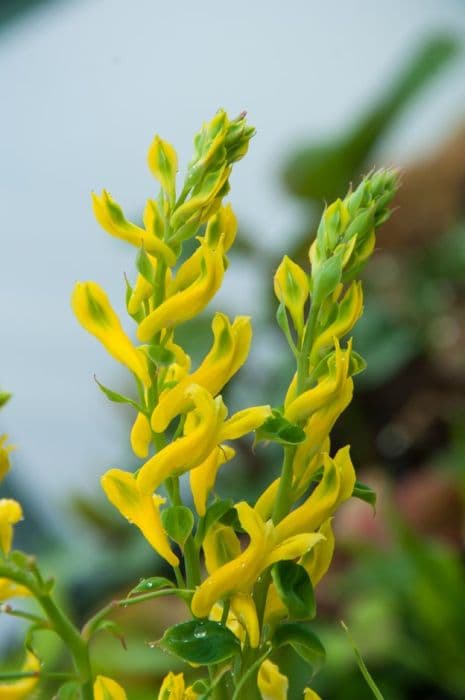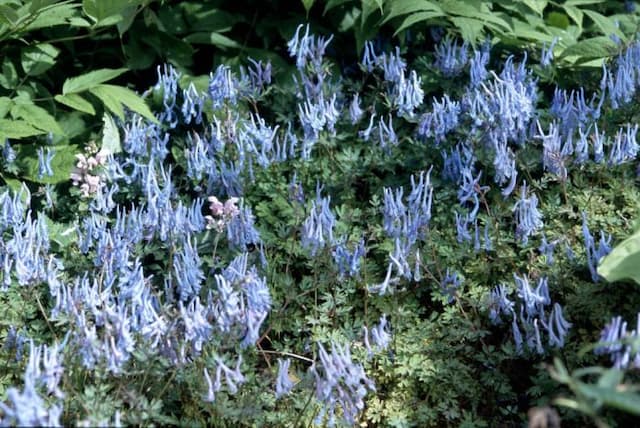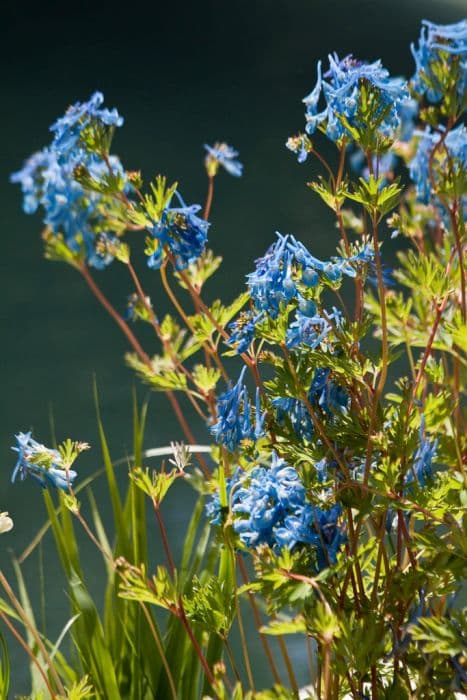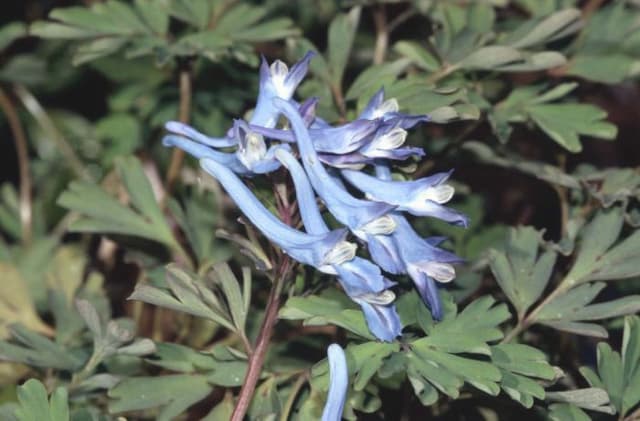California Poppy Eschscholzia californica 'Apricot Chiffon' (Thai Silk Series)

ABOUT
The California poppy 'Apricot Chiffon' from the Thai Silk Series is a striking plant known for its unique and colorful blooms. Its flowers exhibit a lush, apricot hue with a delicate, silky texture. The petals have a subtly ruffled look, adding a touch of elegance to the overall appearance. Each flower consists of four broad petals that create a cup-like shape, unfolding elegantly to catch the eye of onlookers. The center of the flower usually bears a contrasting color, typically a deeper shade, which accentuates the soft apricot tones and adds depth to the floral display. The foliage of this variety of California poppy is a blue-green color, which contrasts beautifully with the warmth of the blossoms. The leaves are finely divided, almost fern-like in appearance, and provide a delicate, lacy backdrop for the flowers. This backdrop allows the apricot petals to stand out even more conspicuously in ornamental settings. This plant typically produces multiple flowering stalks, which hold the blooms above the foliage, creating little islands of color that sway gently with the breeze. The overall effect of the California poppy 'Apricot Chiffon' is one of gentle beauty and subtle charm, with its pastel colors and graceful bearing making it an ideal candidate for gardens that aim for a soft color palette or a cottage garden aesthetic. Its distinctive blossoms are not only visually appealing but can also attract pollinators such as bees and butterflies, which add further life and movement to the garden space.
About this plant
 Names
NamesFamily
Papaveraceae
Synonyms
California Poppy, Golden Poppy, California Sunlight, Cup of Gold
Common names
Eschscholzia californica
 Toxicity
ToxicityTo humans
The California poppy is generally considered non-toxic to humans. As a wildflower native to California, it has been part of the natural landscape and does not pose significant health risks upon casual contact or ingestion in small quantities. However, in large amounts, there could be potential for mild sedative effects due to some of its chemical components, though these effects are not typically strong. If an individual were to consume a considerable quantity of California poppy, they might experience mild discomfort or digestive upset, but there are no widely recognized severe symptoms of poisoning from this plant for humans. As with any plant, some people may have allergies or sensitivities, so it's prudent to be cautious if you're not sure how you might react.
To pets
The California poppy is not considered highly toxic to pets. It is a naturally occurring wildflower in many areas and does not typically present a significant danger to animals if they come into contact with it or ingest small amounts. Nonetheless, the plant does contain alkaloids that can potentially act as a mild sedative, so in larger quantities, it may cause mild sedation or lethargy in pets. If a pet were to ingest a large amount of California poppy, they might experience minimal gastrointestinal upset, such as diarrhea or vomiting. The risk of severe poisoning is low, but as with any non-food plant, it is best to prevent your pets from consuming it to avoid any potential negative reactions.
 Characteristics
CharacteristicsLife cycle
Perennials
Foliage type
Evergreen
Color of leaves
Blue-green
Flower color
Apricot
Height
1 foot [30 cm]
Spread
1 foot [30 cm]
Plant type
Herb
Hardiness zones
6
Native area
California
Benefits
 General Benefits
General Benefits- Aesthetic Appeal: Produces showy apricot-colored blooms that add color and visual interest to gardens and landscapes.
- Drought Tolerance: Naturally adapted to dry conditions, making it suitable for xeriscaping and water-efficient gardening practices.
- Easy Maintenance: Requires minimal care once established, making it an ideal choice for low-maintenance gardens.
- Pollinator Attraction: Flowers attract pollinators such as bees and butterflies, supporting local ecosystems and biodiversity.
- Adaptability: Can thrive in a variety of soil types, from sandy to average garden soils.
- Self-seeding: Often reseeds itself, providing a natural means of propagation and sustained display year after year.
- Fast Growth: Typically grows quickly, allowing for a rapid establishment and fast filling-in of garden spaces.
- Long Blooming Period: Often blooms from late spring into summer, offering a prolonged period of floral interest.
- Edging and Borders: Suitable for use as a border plant or for edging paths and walkways.
 Medical Properties
Medical Properties- Anxiety Relief: California poppy has been historically used to alleviate anxiety and nervous tension.
- Sleep Aid: It may help in improving sleep quality and addressing insomnia due to its mild sedative properties.
- Pain Relief: The plant has analgesic properties that may help in reducing pain.
- Antispasmodic: It can be used to relieve muscle spasms and cramps.
 Air-purifying Qualities
Air-purifying QualitiesThis plant is not specifically known for air purifying qualities.
 Other Uses
Other Uses- Photography Prop: The California poppy 'Apricot Chiffon' creates a stunning backdrop or focal point for outdoor photography, offering a vivid and unique color contrast.
- Textile Dyeing: Petals of the California poppy 'Apricot Chiffon' can be used to create a variety of dyes for textiles, producing soft, apricot hues on fabrics.
- Eco-friendly Confetti: Dried petals can be used as eco-friendly confetti for weddings and celebrations, providing a natural and biodegradable alternative to traditional confetti.
- Culinary Garnish: Edible petals of the California poppy 'Apricot Chiffon' can be used to add a splash of color to salads and desserts, though they do not have a significant flavor.
- Artistic Inspiration: Artists may draw inspiration from the unique colors and form of the California poppy 'Apricot Chiffon' for painting, drawing, or other visual arts.
- Natural Potpourri: Dried California poppy 'Apricot Chiffon' petals can be mixed with other aromatic herbs to create a natural potpourri for home fragrance.
- Bookmark Creation: Pressed flowers of the California poppy 'Apricot Chiffon' can be laminated or encased in resin to create unique, botanical bookmarks.
- Soap Making: The petals can be embedded in homemade soaps for decoration, adding a touch of natural beauty to bath products.
- Floral Water: While lacking strong scent, petals of the California poppy 'Apricot Chiffon' may still be used to create a subtly scented floral water for cosmetic use.
- Craft Projects: Petals and seed pods can be used in various craft projects, such as creating greeting cards, collages, or as part of floral arrangements.
Interesting Facts
 Feng Shui
Feng ShuiThe California Poppy is not used in Feng Shui practice.
 Zodiac Sign Compitability
Zodiac Sign CompitabilityThe California Poppy is not used in astrology practice.
 Plant Symbolism
Plant Symbolism- Resilience: The California poppy, including the 'Apricot Chiffon' variety, is famed for its ability to thrive in harsh conditions, often growing in poor soil with minimal water.
- Beauty and Delicacy: The 'Apricot Chiffon' variety, with its soft, pastel hues and delicate petals, symbolizes the inherent beauty and fragility of nature.
- Peace: In general, poppies are associated with peace and rest due to their sedative properties, and the California poppy also embodies this symbolism with its tranquil appearance.
- Remembrance: While the red poppy is more commonly associated with remembrance, the California poppy too shares this symbolism as it is a poppy variety, serving as a token of memory and respect.
- Transformation: As an annual plant that blooms anew each year, the California poppy can symbolize change, rebirth, and the cycle of life.
 Water
WaterThe California poppy, including the 'Apricot Chiffon' variety, prefers well-drained soil and does not require frequent watering. During the growing season, water these plants once a week with about 1 to 1.5 gallons per square yard, depending on the climate and weather conditions. Ensure the soil is dry to the touch between watering sessions to avoid overwatering. In hotter, drier conditions, monitor the plant more closely as it might need watering more often. It’s better to underwater than to overwater the California poppy, as they are drought-tolerant.
 Light
LightCalifornia poppies thrive in full sunlight and should be placed in a spot where they receive at least 6 to 8 hours of direct sunlight daily. The 'Apricot Chiffon' will perform well in light conditions ranging from full sun to partial shade, but flowering is more prolific with greater sun exposure. Avoid heavily shaded locations as this can impede growth and reduce blooming.
 Temperature
TemperatureThe California poppy is well-adapted to a range of temperatures and performs best in conditions between 50°F and 75°F. It can survive minimum temperatures down to around 10°F and maximum temperatures well into the 90s. The ideal growing conditions are warm days and cooler nights, which are typical of its native California and Mediterranean climates.
 Pruning
PruningPruning is generally not necessary for the California poppy, but deadheading the spent blooms will encourage further flowering. After the blooming season, you can cut back the foliage to promote a second bloom in the same season. It’s best to prune the 'Apricot Chiffon' California poppy only to remove dead flowers or occasionally to shape the plant.
 Cleaning
CleaningNot needed
 Soil
SoilThe California Poppy 'Apricot Chiffon' thrives in a well-draining soil mix with low fertility and prefers a pH range of 6.0 to 7.5. A blend of sandy loam and gritty material like perlite or pumice is ideal; avoid rich, moist composts.
 Repotting
RepottingCalifornia Poppies 'Apricot Chiffon' are typically grown as annuals and, therefore, do not usually require repotting. If started in containers, they should be transplanted to their growing location while young to avoid root disturbance.
 Humidity & Misting
Humidity & MistingCalifornia Poppy 'Apricot Chiffon' is tolerant of a wide range of humidity levels and thrives in dry conditions; it does not require high humidity environments.
 Suitable locations
Suitable locationsIndoor
Place in bright light, limit water, avoid high humidity for California Poppy.
Outdoor
Full sun, well-drained soil, minimal watering for California Poppy.
Hardiness zone
6-10 USDA
 Life cycle
Life cycleCalifornia Poppy 'Apricot Chiffon' (Thai Silk Series) begins its life cycle when its seed germinates, typically in early spring when soil temperatures reach around 60°F (15°C). Germination is followed by the growth of a basal rosette of leaves, and as temperatures rise, a flower stalk elongates to display the plant's distinctive apricot-colored blooms. The flowering stage occurs from late spring to early autumn, with peak bloom in midsummer, after which pollination by insects like bees ensures the production of seeds. As summer ends and fall approaches, the plant sets seeds that are contained in long, narrow pods. Once mature, these seed pods open, dispersing seeds into the surrounding soil. The plant then enters dormancy as winter sets in, with the cycle beginning anew the following spring if conditions are favorable.
 Propogation
PropogationPropogation time
Spring-Early Summer
The most popular method of propagation for the California poppy 'Apricot Chiffon' is by seed. The best time to sow California poppy seeds is in early spring, directly into the ground where they are to grow. The seeds should be scattered lightly onto well-drained soil and covered with a thin layer of earth, about 1/8 inch (approximately 3 mm) deep. After scattering the seeds, water them gently to ensure contact with the soil and keep the area moist until germination, which usually takes 14 to 21 days. Since California poppies have a taproot system, they don't transplant well, so starting them directly in their permanent location minimizes root disturbance.









